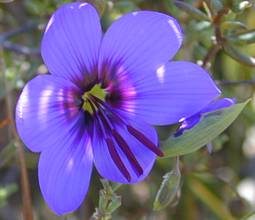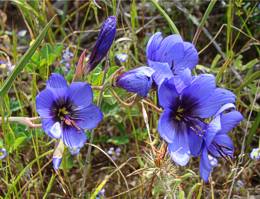Geissorhiza splendidissima
Geissorhiza splendidissima Diels
Family: Iridaceae
Common names: blue pride of Nieuwoudtville (Eng.); blou trots van Nieuwoudtville (Afr.)
Introduction
Because of its beautiful, brilliant, dark purple-blue flowers, Geissorhiza splendidissima is called the blou trots van Nieuwoudtville (blue pride of Nieuwoudtville) by farmers in the area.

Description
Description
The lovely deciduous Geissorhiza splendidissima is a geophyte (a perennial plant which propagates from buds on food storage organs under the soil surface) and the mature bulbs are the size of peas. The stem is velvety and the narrow leaves are cross-shaped in section. This bulbous plant grows 80-200 mm high. The flowers are very attractive, most of the petals are glossy dark purple-blue with a green centre, surrounded by black; the anthers are orange-brown. The seeds are small, fine and dark brown. Flowering is normally from late August to September.

Conservation Status
Status
Geissorhiza splendidisima is listed on the Red Data List as Vulnerable, mainly due to land transformation (farming).
Distribution and habitat
Distribution description
Geissorhiza splendidisima is endemic to the Nieuwoudtville area in the Northern Cape and flowers in stony clay flats in renosterveld vegetation on the Bokkeveld Mountains.
Derivation of name and historical aspects
History
Geissorhiza is derived from the Greek word geisson meaning tile and rhiza meaning roots, which refers to the regular overlapping of the corm tunics in some species, much like tiles on a roof. The species name splendidissima is a Latin-derived word meaning splendid.
The genus Geissorhiza falls under the family Iridaceae and with Hesperantha falls in the subfamily Crocoideae (= Ixioideae), as they have asymmetric corms. Geissorhiza has 84 species that are endemic to South Africa, of which 83 occur in the Northern and Western Cape provinces.
Ecology
Ecology
A variety of insects are responsible for the pollination of the Geissorhiza species. Several species are pollinated by bees. Monkey beetles pollinate those species with a dark centre. Insects see neon colours rather than the purple and red markings that we see.
The seeds generally ripen on the plants and fall quite close to the parent plant, resulting in large colonies growing in damp areas.
On the West Coast, they are eaten by the Namakwa Rock Mouse, and the Cape Porcupine eats them too.

Growing Geissorhiza splendidissima
Grow
It is better to cultivate Geissorhiza splendidissima in pots as it does not grow well if not in its natural habitat.
The best way to grow these plants is from corms, but they are not always easily available, except from specialist growers. Plant the corms in small pots in March (in the southern hemisphere) once the heat of summer has passed. In the northern hemisphere, plant them in October.
One of the most important characteristics of these plants is their vegetative cycle: an alternation of a dormancy phase when the plant rests, which is often in the form of a bulb, corm or rhizome, and a vegetative phase. The word geophyte comes from the Greek word ge meaning ground and indicates that the rest of the organs are buried in the ground.
This winter-growing bulbous plant should be sown in autumn and allowed a long dormant period in summer, when watering must be withheld. Containers are best placed in semi-shade to prevent the corm from drying out.
Use a soil mixture of equal parts river sand and fine compost. The soil should have a slightly acidic pH (potential hydrogen) of no more than 6.0. Fertilizing the plants with a little organic fertilizer, such as KELPAK, during the first year will ensure that the bulbs mature before being stored for their summer rest period. Do not overfeed as this will result in more leaves being produced and fewer flowers.
After flowering, plants should be watered until the leaves start turning yellow, which indicates approaching dormancy. The plants can be left to dry off during the early summer months after which the corms can be dug up and stored in a cool dry place for replanting in early autumn the following year. Never store the corms in plastic bags — they usually sweat and rot!
References
- Du Plessis, N. & Duncan, G. 1989. Bulbous plants of southern Africa. Tafelberg, Cape Town.
- Goldblatt, P. 1985. Revision of the southern African genus Geissorhiza (Iridaceae: Ixioideae). Annals of the Missouri Botanical Garden 72: 277-447.
- Goldblatt, P. & Manning, J.C. 2000. Iridaceae. In O.A. Leistner, Seed plants of southern Africa. Strelitzia 10: 623-638. National Botanical Institute, Pretoria.
Credits
Colleen Rust
Hantam National Botanical Garden
August 2009
Plant Attributes:
Plant Type: Bulb
SA Distribution: Northern Cape, Western Cape
Soil type: Clay
Flowering season: Winter
PH: Alkaline
Flower colour: Blue, Purple
Aspect: Full Sun
Gardening skill: Challenging
Special Features:
Horticultural zones








Rate this article
Article well written and informative
Rate this plant
Is this an interesting plant?
Login to add your Comment
Back to topNot registered yet? Click here to register.